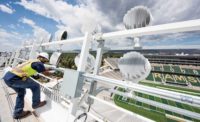Now in its 101st year of business, Utah electrical contracting giant Cache Valley Electric Co. has settled comfortably into not just one market niche, but several. While Cache Valley’s core focus is its electrical construction division, with projects that range from a few thousand dollars to more than $70 million, the contractor’s broad base of specialties also includes an equally robust combination of transmission line and substation work, signals and utilities projects, technology services, teledata and a service division recognized for its rapid response on smaller projects.
Third-generation Cache Valley owner and CEO Jim Laub says the firm has intentionally expanded its services over the years to remain competitive. “We realized years ago that we had to be more diverse. When we were much smaller, we did a lot of government work for the Corps of Engineers and the Defense Department; it was 80% of our work,” Laub says.
“Then in the ’80s, when the recession hit and everyone pulled back on government spending, it was eye-opening. I was just getting started in the business and wasn’t very smart, but I was smart enough to know not to have all your eggs in one basket. You have to diversify to protect yourself and your employees,” he says.
Today, the contractor works in nearly every major building market—from heavy industrial and manufacturing to health care, large commercial office space and retail—and has achieved a geographical reach into all 50 states and overseas with a team of 1,500 employees.
Cache Valley reported $238.3 million in regional revenue for 2015, up from $171.9 million the previous year. The contractor is ranked third on ENR Mountain States’ list of regional Top Specialty Contractors for 2016. Based on its revenue growth and diverse capabilities, ENR regional editors selected Cache Valley Electric as the Mountain States Specialty Firm of the Year for 2016.
Division of Duties
Each of Cache Valley’s six office locations concentrates on a key market niche, and, for the most part, they operate independently of each other. The Dallas office focuses on technology; a Blytheville, Ark., office handles the firm’s steel mill and heavy industrial division; and a Portland, Ore., team specializes in a combination of technology and teledata.
The Salt Lake City and Honolulu offices tackle projects related to the traditional construction side of the business, while the company’s headquarters in Logan, Utah, does out-of-state heavy industrial work.
Despite the contractor’s size and geographic reach, Laub insists a great staff and division managers make his job easy. “We don’t have a lot of company meetings,” he says. “We hire people to lead their division, and they take great pride in the company, just as I have great pride in them.”
“Cache Valley goes the extra mile to help us think out of the box if we’ve missed [the mark] somewhere,” says Jana Doggett, deputy athletics director at Utah State University, who has worked with Cache Valley on several university projects, including the recently completed renovation and expansion of Utah State’s Maverik Stadium in Logan.
“Not only are they good at what they do from a professional standpoint, but they are local here in Logan, and a good number of their employees are Aggie fans in the stadium,” Doggett adds. Electrical distribution, lighting, voice and data and multimedia work all were done within the active campus environment at USU.
Diversified Portfolio
“As a specialty contractor, our electrical expertise—design-build, service, line and substations—is 101 years old, and we like to think we’re really good at that,” says Nate Wickizer, Cache Valley’s chief operating officer,.
Wickizer says the more finely tuned diversification of services that Cache Valley has implemented during the past 20 years has enabled the traditional elements of the electrical contracting business to go hand in hand with the addition of cutting-edge technology, creating a turn-key service, so to speak, one that provides customers with a unique benefit, he says.
“Technology is becoming a big part of what we’re doing today—just as it’s becoming more a part of everyone’s lives,” Laub says. “However, some of the biggest projects we do year in and year out are still the traditional projects like steel mills, and one of our largest (current) projects is a greenfield steel mill in Osceola, Arkansas: Big River Steel,” he says.
Cache Valley’s scope on the 1,300-acre site includes electrical construction, low-voltage work and wireless-network infrastructure.
“Many people think steel mills are a dying industry; they’re anything but. It’s a growing industry in the U.S., and we’re excited to be a part of it,” Laub says.
Cache Valley’s line division is in the second year of a four-year contract with Dixie Power to install transmission and distribution lines to meet growth needs in the St. George, Utah, area. The contractor’s initial scope of work involved installing 25 miles of transmission and distribution lines. The 69-kv and 138-kv transmission lines take power to the substations, where it steps down to a 12-kv distribution line for use by homes and businesses. Ongoing work entails installing additional segments along the line.
In November, Cache Valley completed the 24-floor, LEED Gold-designed 111 Main office building in downtown Salt Lake City. The building’s sustainable, high-performance design will enable it to operate 15% below the state’s energy code. Cache Valley’s scope of work included providing power distribution, low-voltage cabling and fiber optics, as well as state-of-the-art security and card access systems for the high-profile project.
Cache Valley Electric’s Recent Projects 1
11 Main, Salt Lake City
Varian Medical, Salt Lake City
Biofire Diagnostics, Salt Lake City
Kapi’olani Medical Center, Oahu, Hawaii
Maverik Stadium at Utah State University, Logan, Utah
Adobe, Lehi, Utah
Confidential Data Center, Salt Lake City
Big River Steel, Osceola, Ark. (in progress)







Post a comment to this article
Report Abusive Comment